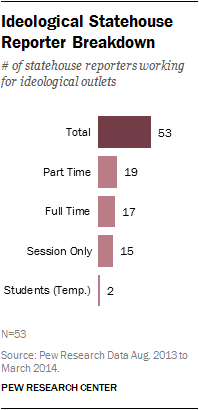 When the bottom fell out of the news industry during the recession, many newspapers cut their reporting power in statehouse press rooms, abandoning desks and pulling journalists from a beat that dailies had long dominated.
When the bottom fell out of the news industry during the recession, many newspapers cut their reporting power in statehouse press rooms, abandoning desks and pulling journalists from a beat that dailies had long dominated.
Just as quickly, other organizations moved to fill the void. Among them: groups with stated points of view.
A new Pew Research study identified 33 ideological outlets that assign reporters to cover state government. These outlets clearly state an underlying political philosophy, often on their websites. Most of them identify themselves as supporters of a “free market” or “limited government.” One says it provides “news for Republicans, by Republicans.” Just one identifies itself as “progressive.”
Ideological organizations cover state government in 25 states across the country. (Florida has the most ideological outlets, with three.) They assign 53 reporters to statehouses, about one-third of them (17) full time and year round. The rest cover the statehouse part time (19) or during legislative sessions only (15). Two others are college students.
While they represent just 3% of the 1,592 reporters covering statehouses for all types of news outlets—and 2% of the 741 who do so full time—these reporters and the organizations they work for highlight a notable shift in the media landscape.
“It’s the same story I assume in state capitols all over the country: some of the vacuum has been filled by advocacy groups,” said Rob Christensen, of the (Raleigh) News & Observer, a newspaper reporter who has covered the North Carolina statehouse for more than three decades. “So in some ways, there’s more light being shown on activity than ever. But there are fewer impartial news organizations bird-dogging the legislature.”
The vast majority of the ideological organizations were created in the past six years in an effort to fill gaps in coverage. Their growth coincides with sharp drops in newspaper staffing in general and in statehouses in particular. In a comparison with previous studies by American Journalism Review, Pew found that newspapers cut the number of reporters assigned to statehouses full time by 35% between 2003 and 2014. From 2003 to 2012, the latest year for which data are available, overall full-time newspaper staffing declined by 30%, according to the American Society of News Editors.
Numerically speaking, the ideological outlets have made a small dent. Pew’s comparison with AJR shows that newspapers cut 164 full-time statehouse reporters in 11 years. To date, ideological organizations have added just 17.
The Franklin Center for Government & Public Integrity, a nonprofit that owns 14 of the 33 ideological outlets, was founded in 2009 “to address the falloff in statehouse reporting as well as the steep decline in investigative reporting in the country,” said spokesman Michael Moroney. The center, based in Alexandria, Va., supports a free market, he said. The Franklin Center posts stories on a variety of issues on its state-by-state websites, linked on watchdog.org, and syndicates them for use in newspapers. Top stories on July 11 included two about Republican rifts in Pennsylvania and Mississippi, one about how budget cuts led to reductions in Florida police forces and one about an influx of undocumented children in Nebraska.
Sunshine State News was founded in 2010 with investments by “three people who want to see the other side of the news covered,” said Nancy Smith, executive editor of the website, which she described as a “right of center” counterweight to what she sees as liberal media bias. (The organization does not disclose the names of its funders.) “Our feeling was in Tallahassee and many other statehouses, there really wasn’t anybody who was looking at the other side of the story.” Like many of those working for ideological publications, Smith has roots in legacy media; she was an editor at The Stuart News/Port St. Lucie News for 28 years and is former president of the Florida Society of Newspaper Editors.
Still, there can be some friction between reporters who cover state government for ideological outlets and those who work for more traditional news organizations. Last year, Media Trackers criticized the Ohio Legislative Correspondents’ Association after its request for membership in the association was rejected, writing that “the fact that we were honest about our conservative perspective was unacceptable.”
A similar scenario played out in with Media Trackers in Montana, according to Mike Dennison, a statehouse reporter in Helena for Lee Enterprises.
“They were going to take up space in our [capitol] newsroom, and we kicked them out,” Dennison said. The rest of the statehouse press corps, he added, “made it clear that they shouldn’t be there.”


